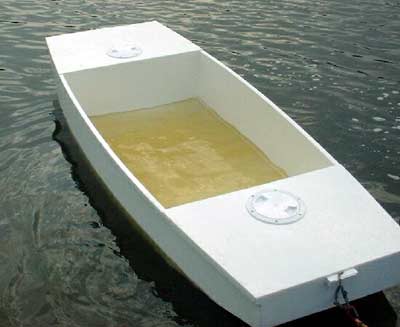Flats Rat
design by "Shorty"
Routh
Mouse Kayak
This is about the simplest and smallest boat that can carry
an adult. The original
mouse was designed by Gavin Atkin. He has made
several variations of the original mouse including a sailing
version, a flat sided one for ultra simple
construction, and a very stable one for fishing. This is
a kayak I designed by copying his original mouse, using
plain flat panels for nail and glue construction instead
of stitch and tape as the original one requires.
To see the plans for this boat [click
here]
Length: 8'
Beam: 34.5" (across top of gunwales)
Max Depth: 14"
Freeboard with 300 lbs load: 8"
Paddling Speed: 3.2 mph

Paddling Performance
At the "Lazy Stealth" speed where I am paddling
with very little effort, I go about 2.5 mph. At the "Going
Somewhere" speed where I am paddling for a long distance
at a sustained effort level, I averaged 3.2 mph. The fastest
I could get the kayak to go, down hill with a tail wind,
huffing and puffing, was 4.0 mph.
Paddling into choppy water is a bit of
a challenge, because of the blunt bow. On a trip at Lake
Conroe, I started off wanting to paddle directly up with
a 10 mph wind gusting 25. The wind was blowing from the
long end of the lake so that the chop had some distance
to develop. If I went straight into the wind (and chop),
it would pound the bow splashing over and land inside. When
I steered about 30 degrees off the wind, the pounding /
splashing significantly dissipated. I had my OJ jug bailer
with me, really handy for getting rid of the water; just
stop every now and again to flip the water out. The average
speed paddling into that wind over an hour was 2.5 mph.
Paddling at right angles to the
wind (parallel with the chop) or down wind was much easier,
almost no splashing and I gained a little surfing effect
down the front of the chop. I averaged a speed of 3.6 mph
on the way back.
Self Rescue
While in some shallow water, I set the kayak on it's side
to see how high it would float with just the air boxes.
It only sank in the water a few inches, and then when I
let it down this is how much water was left inside. I waded
out into some deeper water and tried to board over the stern.
If I grabbed the gunwales and then pulled myself up over
the stern, the aft air box was adequate, and I could self
rescue.

I tried to reboard by climbing
over the side. That worked as well, but there was a significant
amount of water in the cockpit afterwards, with only a few
inches of freeboard.
Here is the skeg. I think it is just about
the right size. It does a good job of tracking, yet it is
still easy to turn.

|

